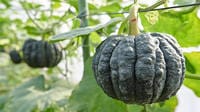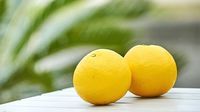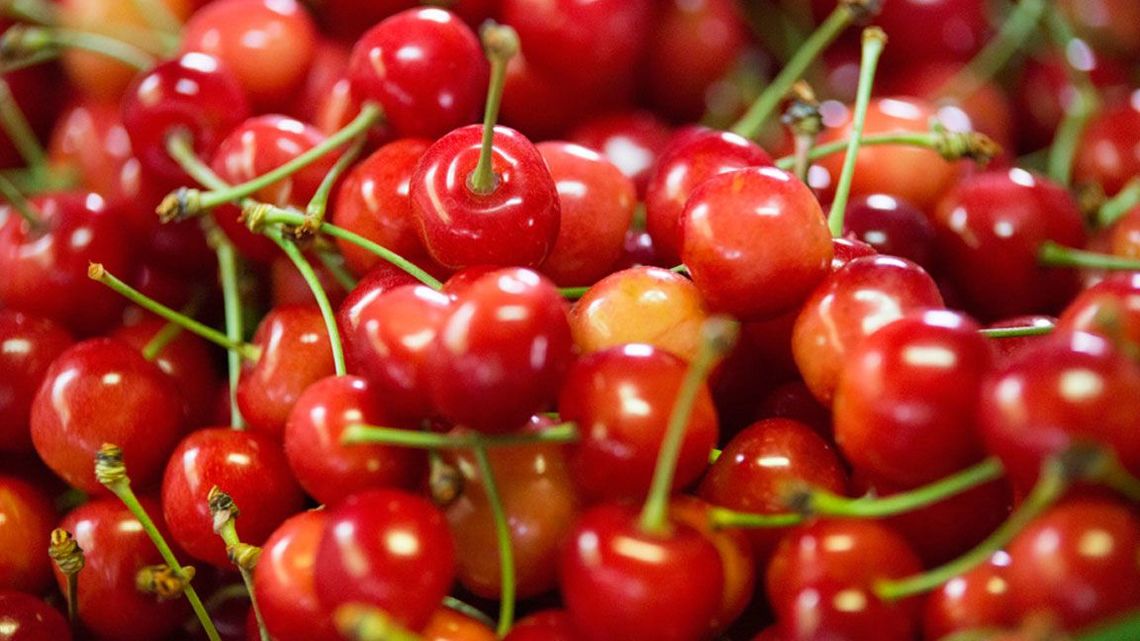

Cherries are one of the representative fruits of Japanese summers. The vivid red cherries are so beautiful that they are almost too good to be eaten. Cherries are famous for coming from Yamagata Prefecture, which boasts over 70% of the total cherry production in Japan. The region called Murayama, yields especially tasty cherries because of its characteristic four-season climate, and its being a basin surrounded by mountains. We visited Murayama when cherries were in their peak season.
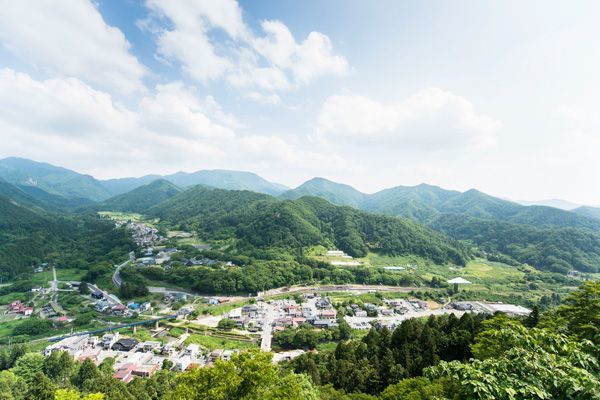
Ample sunshine makes cherries red
Murayama has a concentration of cherry orchards. When the harvest season approaches, the town becomes full of tall, vinyl greenhouses. Peeking into a greenhouse, we see there are cherry trees full of bright red cherries, seeming eager for harvest time to come.
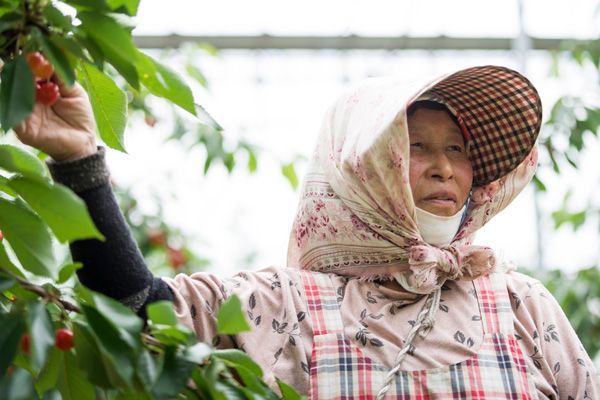
Murayama is a region with many fruit growers, centered around Yamagata Basin with mountains all around. The greatest reason for it being a place of tasty cherries is not just its well-drained soil or ample water sources, but the fact the region has two prerequisites: temperature, and sunshine. In Murayama, the temperature fluctuates greatly between day and night, and there are also distinct four seasons. During the day there is much sunshine but at dusk the air cools down, which gives cherries concentrated nutrients and their great taste.
Summer is the busiest time of the year for cherry orchards

At solstice, when daylight hours are the longest, cherry orchards in Murayama were hitting their peak harvest season.
The orchard of Shizue Shibata, who has been growing cherries for about 50 years, is in Higashine, Yamagata Prefecture, known as the origin of the major cherry type satonishiki. When we stepped into the neatly organized orchard, countless bright red cherries were hanging from every branch, almost about to burst. Shizue picked a satonishiki cherry ready for harvest and handed it over to us. “Try it,” she said. In our mouths, plenty of sweet and sour juice oozed out. We were stunned by the freshness and rich flavor.
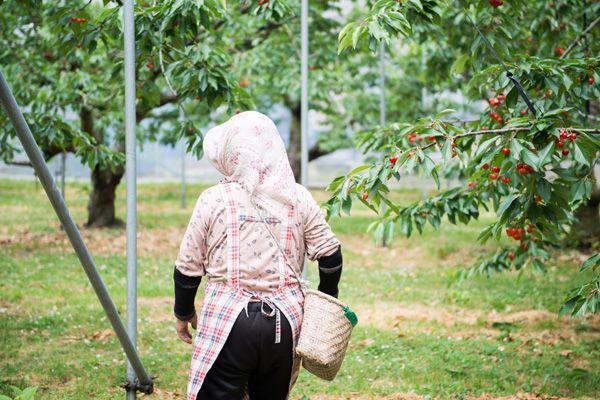
The harvest period, from June to early July, is the hardest time of the year for cherry producers. They start harvesting from four in the morning and continue until noon. In the afternoon they are busy packing and shipping the cherries.
“Cherries have to be picked early in the morning. When the sun rises and it gets warmer, cherries become soft and lose their good texture. The timing of picking cherries is important. If you leave them too long cherries become too dark. You have to know when they are tastiest.”
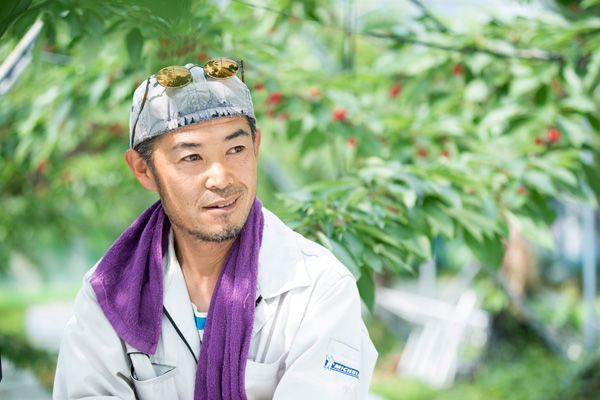
With a skilled movement, Shizue hand-picks cherries and throws them into the basket attached to her waist. “I love cherries but this season is hard work!” Shizue chuckles, in a Yamagata dialect.
Next, we visited Zaouen in Yamagata, an orchard in the mountains. The cherry fields on the mountain slope receive ample wind, which allegedly helps prevent frost that could damage cherry blossoms in spring.
“Growing cherries is the same as nurturing humans. Cherries do not grow unless they get sunlight, and if high temperatures continue they tend to get damaged. When they get exposed to rain they split, so we put a vinyl roof over them before the rainy season, around May. The roof is about seven meters high. It is a dangerous yet vital task for tasty cherries. I am happy when people tell me the cherries I grow are tasty,” says Koji Yamaguchi, representative director of Zaouen.
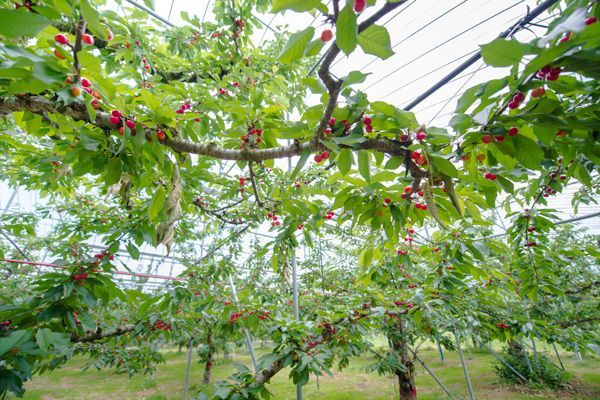
He is busy in the autumn too, harvesting La France pears and kyoho grapes, which he takes prides in, called izunishiki, but he says he feels the joy every day of making and selling products himself.
Savoring the short-lived peak cherry season
Cherries, which signal the start of summer, have a very short peak season. The harvest period for those grown outdoors is only from early June to mid-July. Attention is needed not to miss the peak season since it passes so quickly. Different varieties of cherries become available at stores at slightly different times and they all have different flavors and textures, which are fun to compare.
Satonishiki cherries’ peak season is mid-to-late June. They are soft, fresh and juicy, with a perfect match of sweetness and sourness. The refreshing flavor is soothing in the summer heat.
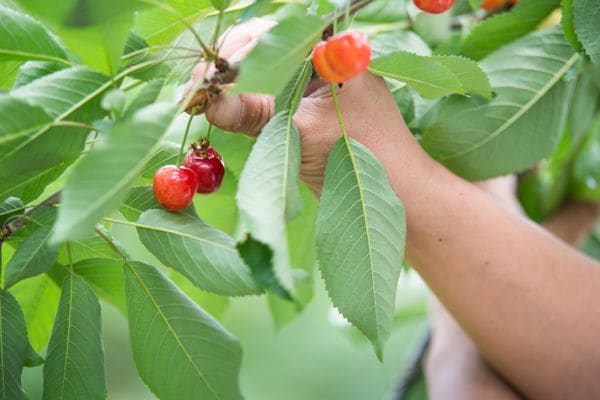
In recent years, a new variety called benishuho is drawing attention, made by crossing satonishiki and tenkonishiki varieties. They are displayed at stores a bit later than other varieties in early July, are very sweet—with a sweetness level exceeding 20—and they are characteristically large. The color is slightly darker than satonishiki. As the fruit is tight and lasts longer, it also makes a popular gift.
Cherries taste best when eaten fresh. Ideally, they are best eaten within two to three days after being picked. So if you want tasty cherries, it is best to eat them fresh in the place they are grown. They are available at michi no eki (roadside stations) and direct-sale outlets, and at orchards that let visitors pick cherries for a fee.
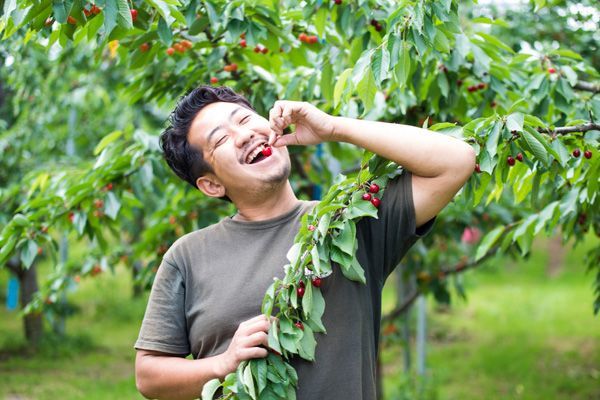
Kawaguchi Kanko Kajuen (translation: Kawaguchi Tourism Orchard) in Kaminoyama makes a special effort preparing good soil using home-made fertilizers. For a limited period between late June and early July, the orchard annually lets tourists pick cherries in one corner of the big orchard. It is a good place to visit during the peak cherry season, as the orchard also runs a direct-sale store for visitors to buy cherries as souvenirs.
Why not savor the summer with the bright red cherries nurtured by Yamagata’s natural environment?
(Writer : ASAKO INOUE / Photographer : RUI YAMAZAKI)

